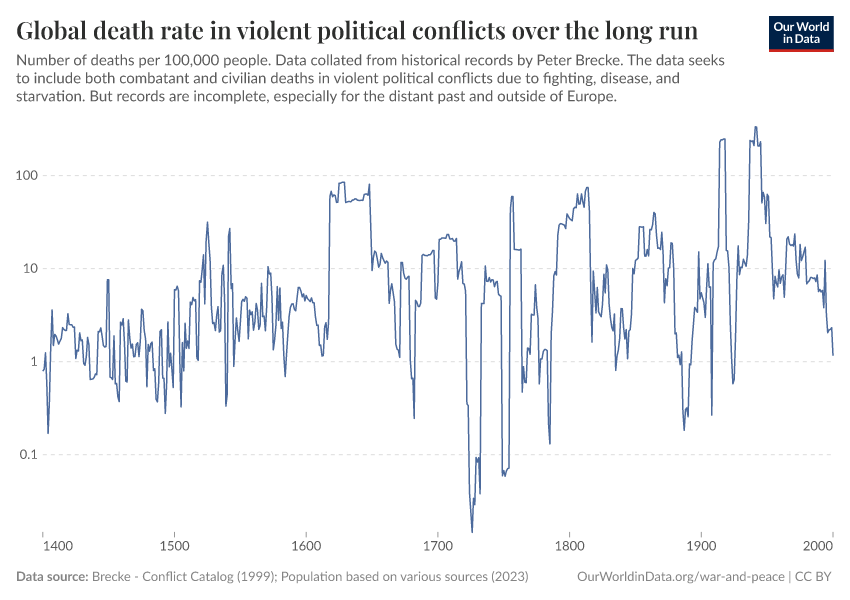Global death rate in violent political conflicts over the long run

What you should know about this indicator
- The data has been collated from a range of historical studies by the political scientist Peter Brecke.
- Brecke seeks to include only political disagreements between organized groups, or between an organized group and civilians, that cause at least 32 deaths during a year. This definition tries to exclude interpersonal and criminal violence.
- His data seeks to include combatant and civilian deaths, counting both direct deaths, due to fighting, and indirect deaths due to disease and starvation.
- The value of this data lies in giving us some insight into conflicts over the very long-run. But there are important limitations. The historical studies on which this data relies vary greatly in terms of how deaths are counted and the reliability of the estimates. Moreover, as Brecke makes clear, the data he has been able to collect provides an incomplete record – particularly for the distant past and outside of Europe.
What you should know about this indicator
- The data has been collated from a range of historical studies by the political scientist Peter Brecke.
- Brecke seeks to include only political disagreements between organized groups, or between an organized group and civilians, that cause at least 32 deaths during a year. This definition tries to exclude interpersonal and criminal violence.
- His data seeks to include combatant and civilian deaths, counting both direct deaths, due to fighting, and indirect deaths due to disease and starvation.
- The value of this data lies in giving us some insight into conflicts over the very long-run. But there are important limitations. The historical studies on which this data relies vary greatly in terms of how deaths are counted and the reliability of the estimates. Moreover, as Brecke makes clear, the data he has been able to collect provides an incomplete record – particularly for the distant past and outside of Europe.
Sources and processing
This data is based on the following sources
How we process data at Our World in Data
All data and visualizations on Our World in Data rely on data sourced from one or several original data providers. Preparing this original data involves several processing steps. Depending on the data, this can include standardizing country names and world region definitions, converting units, calculating derived indicators such as per capita measures, as well as adding or adapting metadata such as the name or the description given to an indicator.
At the link below you can find a detailed description of the structure of our data pipeline, including links to all the code used to prepare data across Our World in Data.
Notes on our processing step for this indicator
Brecke's catalog provides data per conflict. In order to create an annual time series, we sum the deaths recorded in each year across all conflicts, distributing deaths evenly across the duration of conflicts lasting more than one year.
The catalog includes many conflicts for which Brecke was unable to find a deaths estimate. Given Brecke's stated definition of a conflict – political disagreements between organized groups, or between an organized group and civilians, that cause at least 32 deaths during a year – we assign such conflicts 32 deaths when creating the time series.
Reuse this work
- All data produced by third-party providers and made available by Our World in Data are subject to the license terms from the original providers. Our work would not be possible without the data providers we rely on, so we ask you to always cite them appropriately (see below). This is crucial to allow data providers to continue doing their work, enhancing, maintaining and updating valuable data.
- All data, visualizations, and code produced by Our World in Data are completely open access under the Creative Commons BY license. You have the permission to use, distribute, and reproduce these in any medium, provided the source and authors are credited.
Citations
How to cite this page
To cite this page overall, including any descriptions, FAQs or explanations of the data authored by Our World in Data, please use the following citation:
“Data Page: Global death rate in violent political conflicts over the long run”, part of the following publication: Bastian Herre, Lucas Rodés-Guirao, and Max Roser (2024) - “War and Peace”. Data adapted from Brecke, Various sources. Retrieved from https://archive.ourworldindata.org/20250923-101032/grapher/global-death-rate-in-violent-political-conflicts-over-the-long-run.html [online resource] (archived on September 23, 2025).How to cite this data
In-line citationIf you have limited space (e.g. in data visualizations), you can use this abbreviated in-line citation:
Brecke - Conflict Catalog (1999); Population based on various sources (2023) – with major processing by Our World in DataFull citation
Brecke - Conflict Catalog (1999); Population based on various sources (2023) – with major processing by Our World in Data. “Global death rate in violent political conflicts over the long run” [dataset]. Brecke, “Conflict Catalog”; Various sources, “Population” [original data]. Retrieved November 4, 2025 from https://archive.ourworldindata.org/20250923-101032/grapher/global-death-rate-in-violent-political-conflicts-over-the-long-run.html (archived on September 23, 2025).